Forums
- Forums
- Duggy's Reference Hangar
- USAAF / USN Library
- One Man Airforce
One Man Airforce
Post a reply
- Go to Previous topic
- Go to Next topic
- Go to Welcome
- Go to Introduce Yourself
- Go to General Discussion
- Go to Screenshots, Images and Videos
- Go to Off topic
- Go to Works in Progress
- Go to Skinning Tips / Tutorials
- Go to Skin Requests
- Go to IJAAF Library
- Go to Luftwaffe Library
- Go to RAF Library
- Go to USAAF / USN Library
- Go to Misc Library
- Go to The Ops Room
- Go to Made in Germany
- Go to Campaigns and Missions
- Go to Works in Progress
- Go to Juri's Air-Raid Shelter
- Go to Campaigns and Missions
- Go to Works in Progress
- Go to Skinpacks
- Go to External Projects Discussion
- Go to Books & Resources
-
13 years ago
 Main AdminHere in an up-to-date long-range Fighter Escort base they have just unmasked a "one-man air force," a secret weapon which has chased the Luftwaffe at odds of thirty to one, a typical American pilot and a sensational American airplane. They are Maj. James H. Howard, six feet, two inches of thin-hipped, broad-shouldered, quick-thinking pilot skill and the P-51B airplane, the Mustang.
Main AdminHere in an up-to-date long-range Fighter Escort base they have just unmasked a "one-man air force," a secret weapon which has chased the Luftwaffe at odds of thirty to one, a typical American pilot and a sensational American airplane. They are Maj. James H. Howard, six feet, two inches of thin-hipped, broad-shouldered, quick-thinking pilot skill and the P-51B airplane, the Mustang.
This combination, along with others nearly like it, are setting new world records almost daily as they escort Flying Fortresses and Liberator bombers from Britain into Germany.
They have made trips of over 450 miles to the target, and at times fought in the target area for an hour and then returned. This is roughly equal to taking off from Portland, Oregon flying to San Francisco, fighting, and then flying back.
In the thought that you might want to get a close-up of the hero of this base, I journeyed to Major Howard's group headquarters and spent four days with him and his fellow fighters of the 9th Air Force. I brought back the major's own description of his sensational aerial combat of January 11, when, protecting bombers on a raid over the Oeschersleben Halberstadt Brunswick area, he was seen to take on twenty to thirty two-engine Messerschmitt 110's, eight or more sleek, single-engine fighters and a few odd Dorniers and night fighters. Bomber crews made out reports that they saw six of the enemy go down.
Major Howard?s estimate: two kills, two probables, two damaged.
And I learned that if he is the perfect pattern for an American ace, and the experts tell me you couldn't find a better, there are some rules to follow,. To be like him you need a "hot" airplane and a cool pulse. You must be at home in the highest altitudes and yet "keep your feet on the ground." To follow in his slipstream you must be a very rugged individualist indeed, and practice your credo, you must base your tactics on teamwork. Contradictory?
Perhaps. But well, so is this Maj. James Howell Howard. But he adds up to a colorful story-book character.
To begin with, though he seems so typically American that you swear you've seen him somewhere in the States, he was born thirty years ago in Canton, China. And has spent almost half his life abroad. Though he's got so sort of a record for a day's shooting in this entire Theater of Operations, he started out as a Navy pilot and went from that to a Squadron Leader's command in the famous Flying Tigers of Burma. He was deputy leader there under famous "Scarsdale Jack" Newkirk and took over after Newkirk was killed. He is credited with six and a third Jap planes, and thus he is a double-header ace, an ambidextrous big-leaguer of the skies.
He is as plainly American as the jeep. And like it he is durable, reliable, speedy and possessed of a four-wheel driving mechanism. He uses the "drive" in getting routine jobs done on the ground. In the air he is like a different person entirely. He is a great air "general," a fine strategist and a matchless fighter. He smiles almost constantly up there, his fellow pilots say, and when he lands with a grin and comes in to report you may be sure Goering has been whittled down some more.
He eats sweets almost constantly, doesn't care much for pin-up girls, isn't superstitious, likes the movies but isn't particular about the stars and says he hasn't a regular girl friend. His parents, Dr. and Mrs. Harvey J. Howard, of 20 Crestwood Drive, St. Louis, Mo., used to tell him his branch of the Howard family was related to the Howards, headed here in England by the Duke of Norfolk. So at a recent public function Major Howard asked Queen Elizabeth if the Duke were around. He wasn't, but at the Queen's suggestion wrote Jim Howard a letter. Now they're going to get together for a chat.
The biography of this Lancelot-with-1,500-horsepower can best be told through the nicknames he's earned. "Jimmy" brought him running back in the days when his father was a medical missionary in China and was captured by the bandits there, later to write a book about it. "Slim," he was called when he went to boarding school at Haverford School, Haverford, Pa., and later for three years at John Burroughs High School, St. Louis, and at Pomona College where he prepared for the study of medicine, entering as freshman when Bob Taylor was a senior. He used to play a bit of tennis with the movie star who then had to spell out his name Spangler Arlington Brugh.
The next nickname he earned was that of the "Busy Beaver." But that didn't come until after he had taken up flying in the Navy short course then offered - and completed it successfully to his surprise-flown three years from such famous decks as the Lexington, the Wasp and the Enterprise. (He went into aviation because he'd read books on Lindbergh and the great German ace, Baron von Richtofen, and because it seemed like a good opportunity to learn at Navy expense.)
With the Flying Tigers
Now it seems that a "busy beaver" is a fellow who is just so much in love with activity that he volunteers for whatever comes along. Which is only a partial explanation of why he volunteered at the first opportunity to join the American Volunteer Group being set up to fight the Japs under the direction of General Claire Chennault. Other reasons were that he knew the Japs had to be fought one day, the peace-time Navy had too many anchors and not all of them without gold braid, and he had reason to respect the Chinese people-he'd lived among them many years.
He was stationed at Mingaladon Airdrome and between Dec. 30, 1941 and Feb. 8, 1942 he went on fifty-three missions. He made those old Tomahawks lift many a "scalp." One of his favorite stunts was shooting up Jap airdromes. Over here a job like that is called "rhubarbing," because you get down so low you almost do the weeding. Over there they would listen by the hour to Chennault explaining the Japanese "bible," or book of instructions, they would mark the whole thing down as an exercise, then go out and rev up the battered P-40's and make history with a steady, almost untutored hand. Jim Howard thinks there's been a bit of overwriting done about their "tactics." The two-man system of fighting wasn't devised there, he told me. They trained hard, studied hard and did what they were told, for the most part, but the tune they made the Zeros dance to was played by ear.
Take the time Newkirk, "Tex" Hill and Howard went over and shot up the airfield at Tak. They knew that the Japs had built grandstands for themselves and some Thailand officials whom they hoped to impress with their aerial prowess, and that at a certain hour they could be caught with their kimonos undone. Newkirk was leading, then came Howard, then Hill. Jack was to engage whatever Jap fighters were around, Jim was to strafe planes on the ground, Hill was to help out in either department and, as well, strafe Jap soldiers.
"We swooped down on them and they scattered like ants," Major Howard recalls. "They were losing face every second. Jap soldiers on the runways fired their rifles at us and then were mowed down. Newkirk took on a Zero which came swooping in while I had my eyes glued on a row of airplanes neatly parked along the far strip.
"I saw they were American-built Brewsters and knew immediately that they were ships which had fallen into Jap hands when they invaded Thailand. I determined they'd never get to use those aircraft against us. I darted over there and let the tracers flow. Incendiaries blew up tanks and set them all on fire, but I wasn't satisfied. I ran back and forth over those ships tossing riddling steel into them.
"By George, I was so busy doing that I didn't see a fast Jap fighter who was so close to my tail he was practically getting into the act! But, "Tex" Hill shot him down. As we flew home he told me about it. I didn't believe him. But when I put my hands on those bullet holes later "Tex" said, reprovingly: "Those didn't come from moths, you know."
Howard's former Flying Tiger buddy, "Tex" Hill, shown here climbing into the cockpit of his P-51C Mustang, Hill scored 12 1/4 victories with the Flying Tigers in P-40 Warhawks and added another 6 when attached to the 23rd FG.
Squadron Leader Howard flew long, solitary reconnaissance missions. He escorted bombers. He went on fighter sweeps. He helped organize physical training classes around the airdrome. He rode a bicycle about and kept in trim. Whenever new airplanes would arrive at Rangoon be took his turn going down, seeing the sights, and bringing the new planes back.
He was aid to the Chinese general commanding the air force and he helped plan the layout for the airport at Chungking. He was sorry to see the AVG's disbanded because they had much of the stuff which he so admires: guts and adaptability.
By that time the United States was in the war. It didn't seem right for the Tigers to get a bounty of $500 or so for each Jap shot down when other Americans were happy to do it at G. I. rates. Back in the United States Jim Howard enlisted in the air force and soon was a major. He was assigned to a squadron which seemed hexed with adversity of the grimmer sort. It had lost two squadron leaders, both by flying accidents, and was building up its legends-all negative.
Howard began right here, while the squadron was in training at Salem, Oregon, to earn his next nickname, "The Whip." He was sort of a flying counterpart of that coach from the University of Michigan who earned the name of "Hurry Up" Yost. At any rate he soon had the entire personnel working so hard they forgot the hard luck stories. He taught them team work and gave them confidence. He told them that if they didn't like the airplanes they were flying at the moment, they might get better ones for combat.
Howard on the p-51 Mustang
They did. Soon after landing in England they were assigned the "flier's own type," the Mustangs. Now the Mustang, as Major Howard explained it, originally was manufactured in small numbers for the RAF. On May 10, 1942 it made its first combat mission over an airdrome on the French coast. The pilots who shot up a freight train and two lorries on the way home were enthusiastic. But some of the others who flew it were milder in their praise. This first Mustang was a comparatively low altitude job. In the Mediterranean theater it was flown by Americans for the first time.
The present model was sent here last spring. It is powered by a 1,500-horsepower Packard manufactured Rolls Royce Merlin engine, includes a two stage, two-speed supercharger for altitude, has an updraft carburetor, a four-bladed propeller, and racks under each wing capable of carrying either 500-pound bombs or drop tanks which can hold seventy-five gallons apiece. It has what the pilots say is a "terrific design," and they claim it is the fastest airplane in the world. Of course they understand that almost every American pilot believes his fighter, whatever it is, should have that distinction. But they still say it about the Mustang. Four out of five of all the aviators who told me their personal combat experiences at this post wound up by saying something like this: "But, gee! It wasn't me that did the work that counted for that bugger. It was the airplane."
When Major Howard gets in his ship, which is appropriately entitled and emblazoned "Ding Hao," which means "Very good," they have to put his foot rests up and his seat back so he'll be comfortable. He flies with ordinary uniform trousers, a shirt, sweater and yellow "Mae West" life preserver, flying boots, gloves, helmet and goggles. He says you could fly the Mustang in ordinary street clothes because it has a heater, but you go very high and you'd probably get a bit chilly.
"We have gone on seventeen missions already," he said. "You'll be here when we go on the eighteenth. You can go to the briefing for the trip, watch us take off, listen to the radio as we go into combat, sit in on the intelligence reports when we return and then see the combat films which are made simultaneously with the firing of the guns."
He explained that the first few missions had been light operations over northern France. Then on December 11, 1943, they had escorted bombers to Emden. Two days later they went to Kiel, which was the longest fighter trip in world history, only the public wasn't let in on the secret.
He added, "This ship has no bugs. All the pilots have gone overboard for it. They wouldn't want to have to select any other plane to fight in. And we'd all like to race the Mosquito, the Typhoon, the Spitfire, P-38, P-47, or the German Focke-Wulf or Messerschmitt 109."
As we strolled over to the lounge to see films of the famous battle of January 11, Major Howard rounded out the statistics on the Mustang. It weighs about 9,000 pounds, is thirty-two feet eight inches long, thirteen feet eight inches high and has a wing span of thirty-seven feet. Those distinctive propellers have blades eleven feet two inches long. Names painted on ships I saw included "Peg O My Heart," on the ship of Maj. George R. Bickell, of Nutley, N.J., a former brokerage clerk; "Killer," on that of Lieut. Robert W. Stephens, a former professional baseball player, of St. Louis; "Marionette,"on the Mustang flown by Lieut. William P. Nacy, of Jefferson City, Mo., a one-time bank bookkeeper; "Duration Plus," on that of Lieut. Harry E. Fisk, once a railway employee of Spokane, Wash., and "Cisco," on the ship flown by a former member of the RAF, Lieut. Donald D. Nee, of Whittier, Calif.
The film unrolled and even a novice could see that many of the Nazis which Major Howard didn't claim probably never would fly again. The tracer bullets which showed up so clearly were only fired every fifth shot. You were impressed by the accuracy of the major's shooting. He fought at such close quarters that at times the image of the enemy plane was larger than the film. He truly had swept the skies clean.
Here is his own story of the fight in his own words:
Our group was assigned to provide target support for boxes of bombers. "A" squadron was sent to the forward box and I later discovered that this was where all the activity was centered, but at the time I was unable to do anything about it. I just had to use what fighters I had to the best advantage that I could. The bombers passed over the target and there we met our first attacks. Flights of Mustangs were dispatched to engage the attacking enemy aircraft and I began attacking with my flight. On the first encounter, which turned into a melee, my flight lost me, The newspapers headlined "I got lost and I got busy." Well, that wasn't quite accurate. Because, naturally, in a fight like that, you can get separated from the other fellows and that's what happened. But I just don't get lost and neither do our other pilots. When I regained bomber altitude, I discovered I was alone and in the vicinity of the forward boxes of bombers. There was one box of B17's in particular that seemed to be under pressed attack by six single and twin-engine enemy fighters. There were about twenty bombers in a very compact formation and the fighters were working individually.
The first plane I got was a two engine night fighter. I went down after him, gave him several squirts and watched him crash. He stood out very clearly, silhouetted against the snow that covered the ground. I guess we might have been over Magdeburg. Anyway we were over or nearly over some German town. I could follow that fellow down because with the snow on the ground like that you don't have to worry about miscalculating distance in figuring out the proximity of the earth. I wouldn't do that if the ground was just a brown blur, as it so frequently is if you can see it at all while you're fighting. Well, anyway this fellow went down in a cloud of black smoke and fire and hit the ground.
Shortly after I regained altitude an F-W came cruising along beneath me. He pulled up into the sun when he saw me. I gave him a squirt and I almost ran into his canopy when he threw it off to get out. I saw him bail out.
Then I circled, trying to join up with the other Mustangs. I saw a Messerschmitt 109 just underneath and a few hundred yards ahead of me. He saw me at the same time and chopped his throttle, hoping my speed would carry me on ahead of him. It's an old trick. He started scissoring underneath me but I cut my throttle and started scissoring at the same time. Then we went into a circle dogfight and it was a matter of who could maneuver best.
I dumped twenty-degree flaps and began cutting inside him, so he quit and went into a dive with me after him. I got on his tail and got in some long distance squirts from 300 or 400 yards. I got some strikes on him but I didn't see him hit the ground. I pulled up again and saw an ME-109 and a Mustang running along together. The P-51 saw me coming in from behind and he peeled off while the Messerschmitt started a slow circle. I don't remember whether I shot at him or not. Things happen so fast it's hard to remember in sequence when you get back. And by the way, I never did see thirty or forty of those planes all at once the way the bomber people tell it. I'd see one, give it a squirt, and go up again. There were an awful lot of them around; it was just a matter of shooting at them. But you can be sure I never stopped what I was doing to count them. In slang words, I just seen my duty and done it.
Back up, now, with the bombers, I saw a Messerschmitt 110. I shot at him and got strikes all over him. He flicked over on his back and I could see gas and smoke coming out white and black smoke. (Major Howard did not claim this ship as a "kill.") Bomber crews say they are sure this ship crashed but it could be that the fellow had some sort of smoke equipment to make it appear that he was damaged more than he was.
I climbed back up again with the box of bombers which seemed to need me most. And right away I saw another Messerschmitt tooling up for an attack on the Forts. They often slip in sideways, the way this one was doing. We were both pretty close to the bombers and I was close to him. I gave him a squirt and he headed straight down with black smoke pouring out.
Now I could see that each box of bombers was being harassed by attackers but the majority of them were out of range for me. I had to choose the most opportune target and dive on him before he was able to get within range of the bombers.
Each time I would climb back up to bomber level only to find another enemy aircraft lining up for an attack. I was quite busy in a constant merry-go-round of climbing and diving on attackers, sometimes not firing, my guns but presenting a good enough bluff for them to break off and dive away.
On the first encounters and combat all four guns fired. On the third I had two guns and on the fourth and fifth encounter only one gun. When I got down to one gun I was still engaged in this dive, attack and climb game for another two or three attacks. The enemy aircraft and I would estimate that there were about 100 plus attacking aircraft throughout all the boxes during this period-seemed reluctant to stay and fight and would dive out. The reason for no other friendly aircraft being in the vicinity or with me was that other squadrons had been sent off to deal with attackers, and as I say, it's hard to estimate the number of enemy aircraft present during the major portion of this running fight, but all boxes I could see had some activity around them.
We were supposed on this trip to be with the bombers for about an hour. We had already gone over that time. But I had been using my ammunition sparingly and with one gun working I climbed once more to the port side of the bomber formation. I saw an ME over on the starboard side getting into position for his dirty work and I just dived on him from where I was. I got strikes all over him with my one gun. He turned over on his back and skidded out. He thought he had lost me with the skid and he pulled out into a forty-five degree dive, I followed him down and kept on shooting.
On the next trip up I saw a Dornier 217, I think it was coming alongside the big Friends, probably to throw rockets. I had to work fast but when I dived on him he just left and I never did fire a shot at him. I had to leave shortly thereafter, also. When I got home there wasn't anything more serious than a hole in my left wing. I don't know where I got it, or when.
If we had dispatched more fighters we could have bagged many more. There just weren't enough protection fighters to go around. But, using what we had on hand to good advantage, I believe we came out on top with an impressive score.
The Germans are good fighters. You really have to riddle them to bring 'em down, whereas a few hits on a Jap plane will finish it. The Japs aren't very good shots either, but they are more alert than the German pilots. The Japs flew different planes and the formations were different, so it is hard to compare the fight here with the fighting in the air out in the Pacific. This is the biggest air offensive center in the world here and it was on a small scale, remember, when we were fighting there with Chennault.
I'll tell you one thing, though. You have a better feeling flying over France and Germany in a single-engine plane than you have flying in Burma. You have the feeling you'll get better treatment here if you go down. Over there once you are shot down you are either lost or you fall into the hands of the Japanese. I have a personal hatred for every Jap that I don't feel for the Germans.
Now since Major Howard had only reported two planes shot down, and since on that date three other pilots had also shot down two each out of the total bag of fifteen Germans, there was quite a mystery as to the identity of the lone eagle. Intelligence officers were happy to inform the inquiring bomber crew men that up to date Mustang fliers in a typical, all-American group, had shot down forty-eight, riddled scores of "probables" and damaged many, many others, all with a loss of only six planes, only two of which were shot down. And, they added within this typical group there was one squadron, that one led by Maj. James Howard, which had shot down twenty-two, got seven "probables" and damaged ten more, without loss to themselves. "Just count up those percentages," they suggested.
For another week the bomber crews and officers kept talking and wondering and then finally the films were studied and the encounter reports were written and all of them read carefully and there could be no doubt about it. This seemed certain to be one of those rare instances when a flier's claims would be doubled or even tripled by the confirmation board. If, as seems likely, six victories will be officially recorded, it definitely will constitute a one-day phenomena for combat.
The men who fly with Major Howard know he has a special knack for the dogfight but despite all they know about his individual performances they tell you he is even more outstanding as an air commander. When the enemy is sighted he takes easy command of the situation and has a special genius for disposing his fighters to the best advantage, his deep, even tones coming over the radio in such a fashion as to instill the greatest confidence.
Therefore it seemed entirely logical when, one day over Germany, he saw ten jerries approaching and told off a doughty fighter, "Take your wing man and go get 'em!" Odds of five to one! But without giving the matter much thought the fighters told off realized the major was saving his strength for the fierce battle he expected over the target. That was strategy. You must never let the enemy intercept and engage too much of your strength before you are near the target area.
"When he flies into enemy territory and the Huns come up," said Lieut. Mike Rogers, of Newton, Mass., "he, always saves the biggest group of enemy fighters for his own fight."
He is direct in the air. In his dealings with his men on the ground they find him sincere, quietly sympathetic, not very communicative. He gets things done much of the time by indirection. The boys say they feel that may have come about because of his many years in the Orient. When he puts on wings he takes off his cloak of restraint.
So do the pilots who fly with him. They have developed into scientific daredevils. They fly closer to the enemy and do more of the supposedly unorthodox than any other bunch, and the others freely admit it. This spirit has swept the entire group, which is headed by a full colonel, only 27 years old, Kenneth R. Martin, also a Missourian who has to be shown. He's from Kansas City.
When I tried to congratulate Howard's fellow officers they showed me a batch of letters the major had received from Fortress bomber crews he'd protected that memorable day.
Col. Howard W. Bowman, commandant of a bomber station, wrote:
"In the full knowledge that words can not be found which will adequately express our feelings, I wish to convey on behalf of our group the heartfelt appreciation which we feel as a result of the unbelievable courage and heroism you displayed on the recent Oeschersleben mission. "Your unprecedented action in flying your P-51B alone and unaided into a swarm of German fighter planes estimated at between thirty and forty in an effort, to protect our Fortresses in the target area is a feat deserving of the highest commendation and praise. The fact that the odds were overwhelmingly against you and that you had no hope of receiving assistance in your unequal struggle did not deter you in your determination to engage the enemy. "As one officer put it, "It was a case of one lone American taking on the entire Luftwaffe." Members of our group were lavish in their descriptions of the way you shot down enemy planes and, in particular, spoke in glowing terms of the attempts made to protect the combat wing against enemy attacks. I personally feel that your exploits that day evidenced the spirit of team work which is the sina qua non of successful military operations. Let me assure you that should you ever have occasion to visit this station your welcome will be a warm one. There is not a man in our group who hasn't sung your praises . ."
That letter was forwarded to Major Howard at the same time Major General Jimmy Doolittle ordered that a recommendation for "a suitable award" be drawn up. The award was the Distinguished Flying Cross. The citation which accompanied it spoke of Major Howard's "aggressiveness in combat and outstanding leadership as an aerial leader," a flier who inspired his men by personal example and indoctrinated them in a most successful combat technique.
There were other letters, dozens of them, where the officers who had been protected offered the keys to "the works" -planes, hangars and commissary.
And to watch the major get set for his eighteenth mission, you'd believe he expected every day of combat to be a "champagne day." He smiled quietly through the briefing.
Came the take-off and soon we could hear the radio busy giving directions to some of, the heavy armada who would have to come back because of trouble of some sort or another. We could hear the motors of the heavies which had made an abortive start. One landed at our base briefly and then went on home.
It didn't seem long before we heard the electrifying words that meant all were over the target-which was Frankfort, Germany-and that "Big Friends are being attacked."
And yet in the space of two hours all the Mustang pilots had come trooping into the interrogation room and were making calm, concise reports. The flak had been accurate at certain points, the weather had been "ten-ten," which means they hadn't been able to see the ground except on take-off and landing.
But they had done their jobs and so had the bombers. Germany had taken another shellacking and was down hill just that much more on the inevitable path to defeat.
Sources:
"TRUE" Magazine, June 1944
The man himself.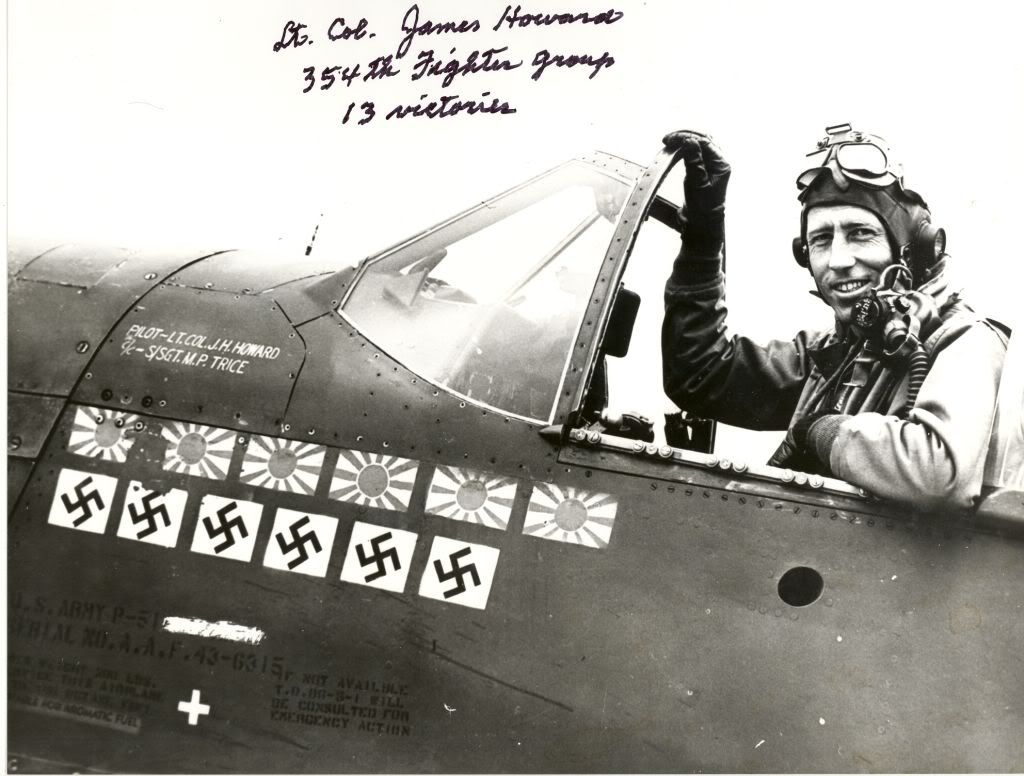
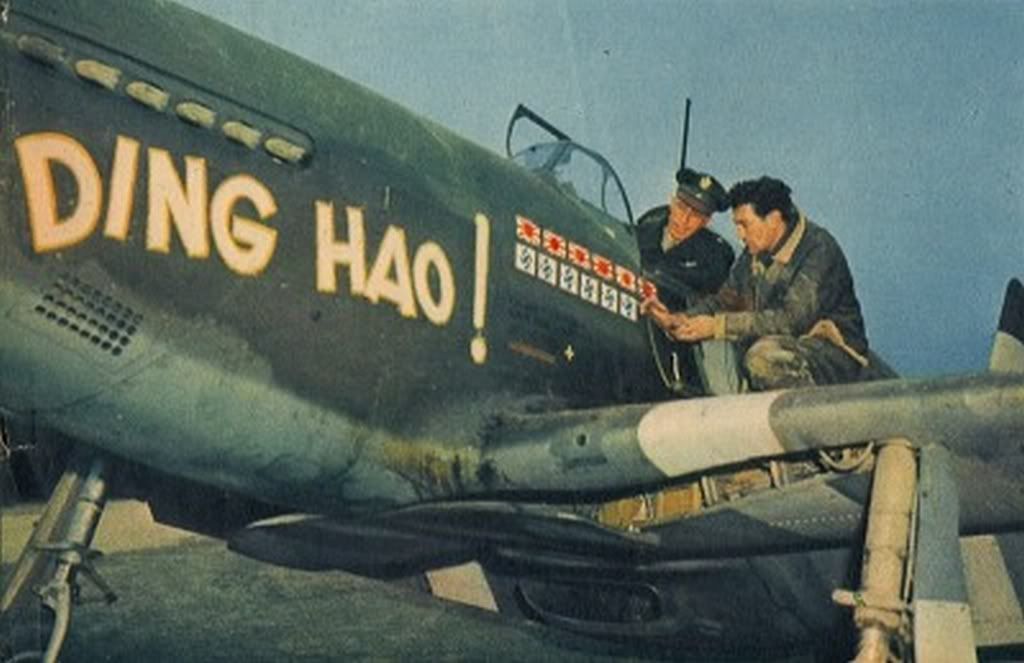
His 110 engagement ( from his gun camera)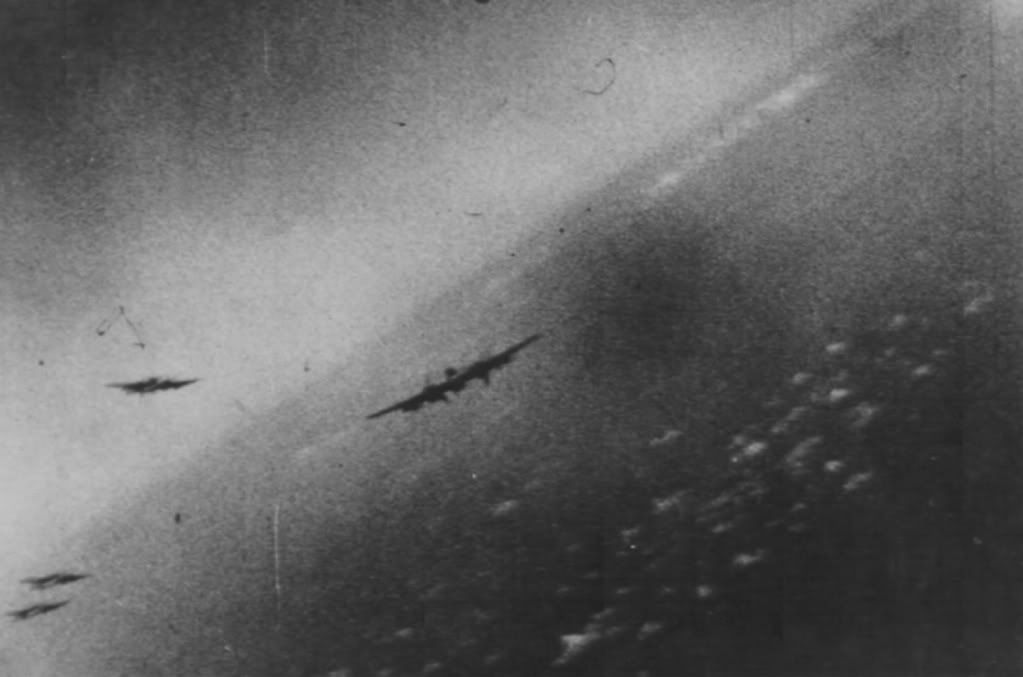
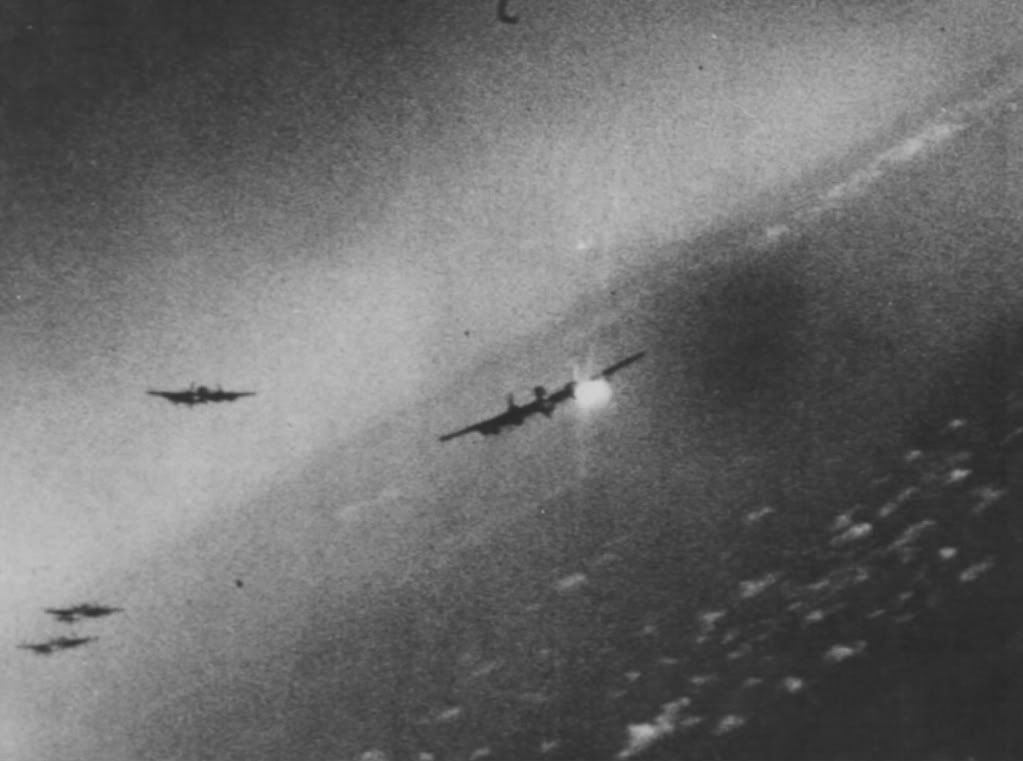
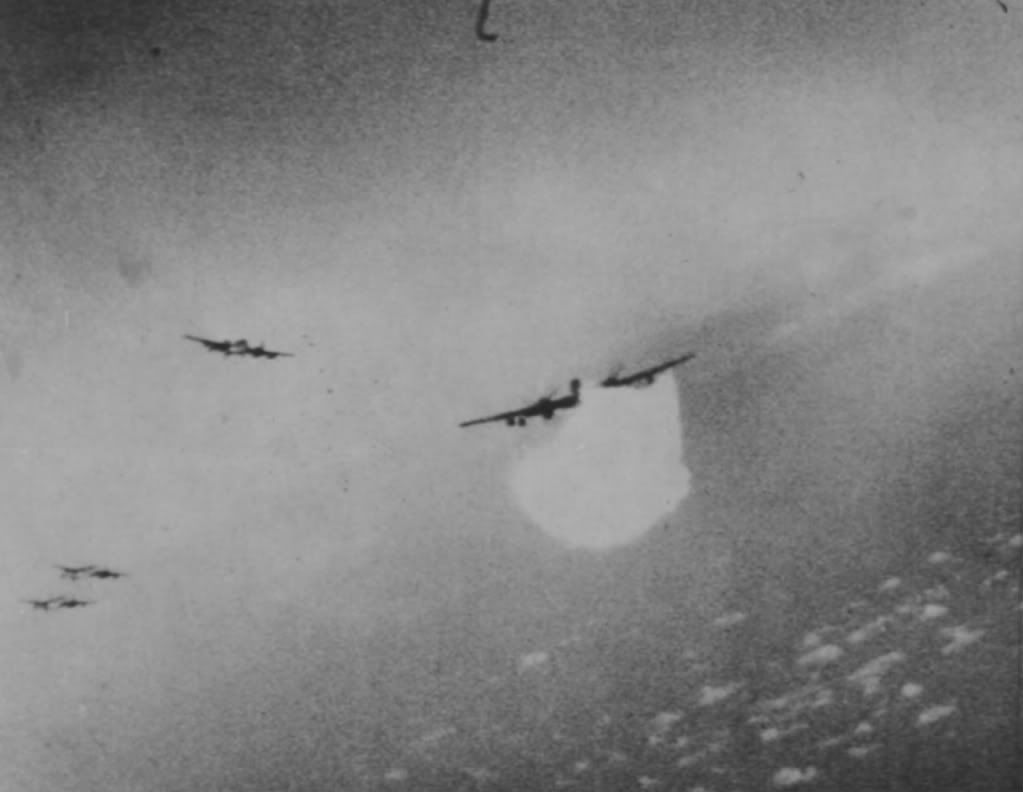
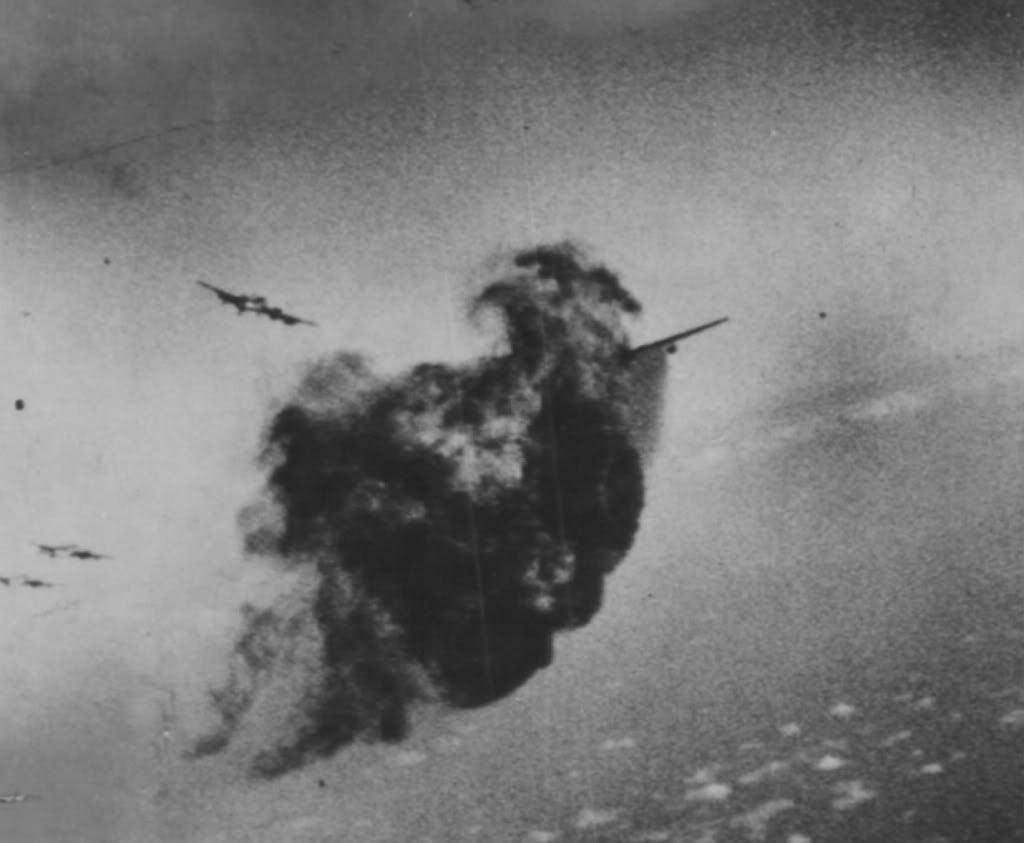
Regards Duggy.
Post a reply
- Go to Previous topic
- Go to Next topic
- Go to Welcome
- Go to Introduce Yourself
- Go to General Discussion
- Go to Screenshots, Images and Videos
- Go to Off topic
- Go to Works in Progress
- Go to Skinning Tips / Tutorials
- Go to Skin Requests
- Go to IJAAF Library
- Go to Luftwaffe Library
- Go to RAF Library
- Go to USAAF / USN Library
- Go to Misc Library
- Go to The Ops Room
- Go to Made in Germany
- Go to Campaigns and Missions
- Go to Works in Progress
- Go to Juri's Air-Raid Shelter
- Go to Campaigns and Missions
- Go to Works in Progress
- Go to Skinpacks
- Go to External Projects Discussion
- Go to Books & Resources
